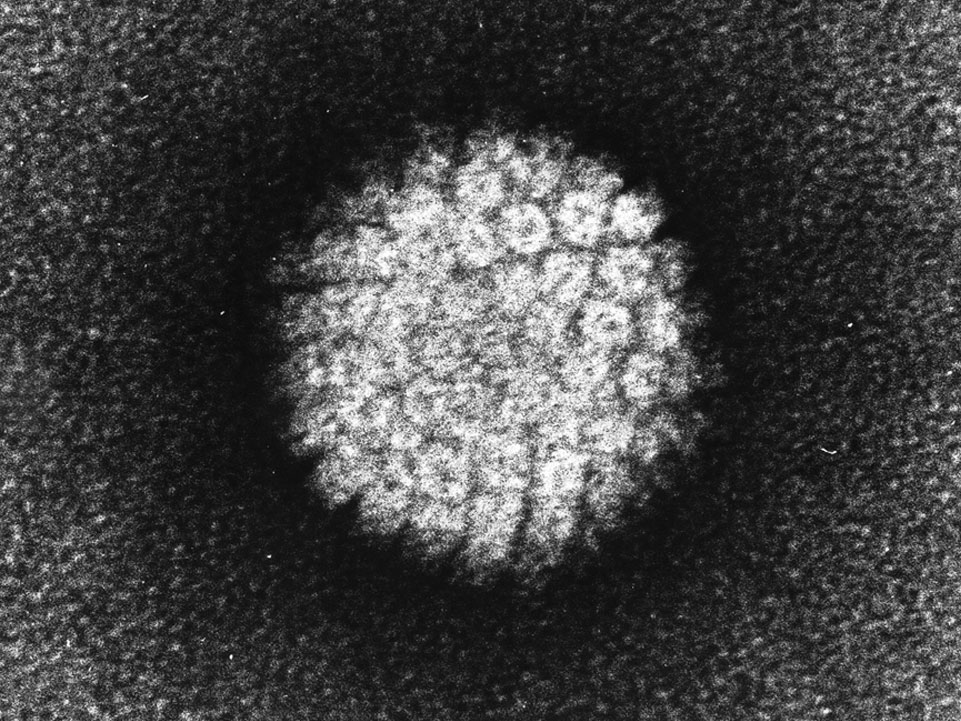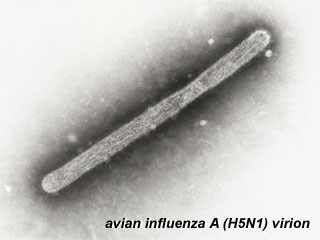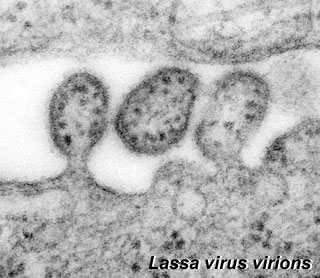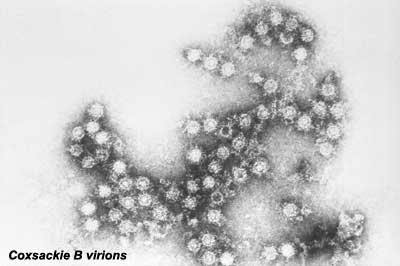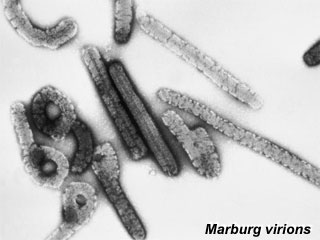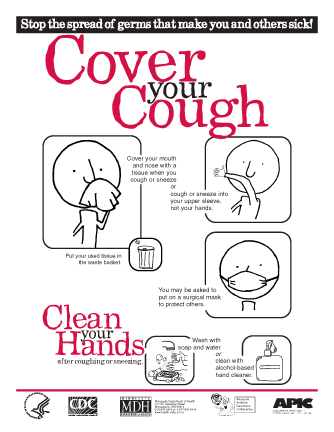Abnormal Development - Viral Infection: Difference between revisions
| Line 82: | Line 82: | ||
==Human Papilloma Virus== | ==Human Papilloma Virus== | ||
(HPV) A group of more that 118 identified viral strains about 40 infect the genital tract and 12 are known to be cancer-causing. Just eight HPV types 16, 18, 45, 33, 31, 52, 58, and 35 in descending order of frequency are responsible for more than 90 percent of cervical cancer cases. (Lancet 2010) | {| | ||
| [[File:Human papilloma virus.jpg]] | |||
Human papilloma virus | |||
| (HPV) A group of more that 118 identified viral strains about 40 infect the genital tract and 12 are known to be cancer-causing. Just eight HPV types 16, 18, 45, 33, 31, 52, 58, and 35 in descending order of frequency are responsible for more than 90 percent of cervical cancer cases. (Lancet 2010) | |||
Infection can be detected by pap smear and at least 2 available vaccines, Cervarix (GSK) and Gardasil (Merck), protect against HPV types 16 and 18, and through cross-protection also partially against HPV types 31 and 45. | Infection can be detected by pap smear and at least 2 available vaccines, Cervarix (GSK) and Gardasil (Merck), protect against HPV types 16 and 18, and through cross-protection also partially against HPV types 31 and 45. | ||
|} | |||
:'''Links:''' CDC [http://www.cdc.gov/std/HPV/STDFact-HPV.htm STD Facts - Human papillomavirus] | Medline Plus [http://www.nlm.nih.gov/medlineplus/hpv.html Human Papillomavirus] | [http://embryology.med.unsw.edu.au/wwwhuman/MCycle/Mcycle.htm#HistoryPapSmear Human Menstrual Cycle - PapSmear]) | :'''Links:''' CDC [http://www.cdc.gov/std/HPV/STDFact-HPV.htm STD Facts - Human papillomavirus] | Medline Plus [http://www.nlm.nih.gov/medlineplus/hpv.html Human Papillomavirus] | [http://embryology.med.unsw.edu.au/wwwhuman/MCycle/Mcycle.htm#HistoryPapSmear Human Menstrual Cycle - PapSmear]) | ||
== Polio Virus == | == Polio Virus == | ||
Revision as of 14:10, 28 November 2010
Introduction
Below is a list of some known maternal, then fetal and postnatal infections that impact upon development. Only a very brief overview is given for each virus for more specific details see the listed internal and external links.
Viruses cannot reproduce by themselves and therefore infect cells to use the cell machinery to produce more virus. Different viruses have genetic material as single- or double-stranded RNA or DNA. The infectious virus particle is called a "virion" and is the genetic material packed in a protein shell. Viruses come in many genetic sizes, as little as 4 proteins up to 200 proteins.
Viral infections can range in their effects from no discernable impact through to severe impacts on development. Furthermore this may occur either directly by the infection or indirectly by the associated maternal fever and other side-effects of the infection. (More? Abnormal Development - Maternal Hyperthermia)
Rubella virus "German Measles" infection during pregnancy is one of the most serious causing congenital rubella syndrome with serious malformations of the developing fetus.
Viral infections have also recently been in the news with the 2009 novel influenza A (H1N1) "Swine Flu" pandemic.
Some early postnatal viral infections can also impact upon development and have been the target for worldwide immunization and eradication.
Human Immunodeficiency Virus (HIV) leads to AIDS and according to United Nations 2005 data about 38.6 million people had HIV. Of the 17.3 million women infected with HIV, 3.28 million gave birth each year (mostly in sub-Saharan Africa), leading to 700,000 new infections of HIV in children each year.
Note also that many cancers can be caused by viruses (papilloma viruses, hepatitis B and C viruses, Epstein-Barr virus and human T-cell lymphotropic virus). Virus-induced cancers account for about 20% of worldwide cancer incidence.
In a few developing countries, and mainly in Africa, at least 3 viruses induce a hemorrhagic fever: Ebola hemorrhagic fever, Marburg virus disease, and Lassa fever.
Some Recent Findings
|
Rubella Virus
Cytomegalovirus
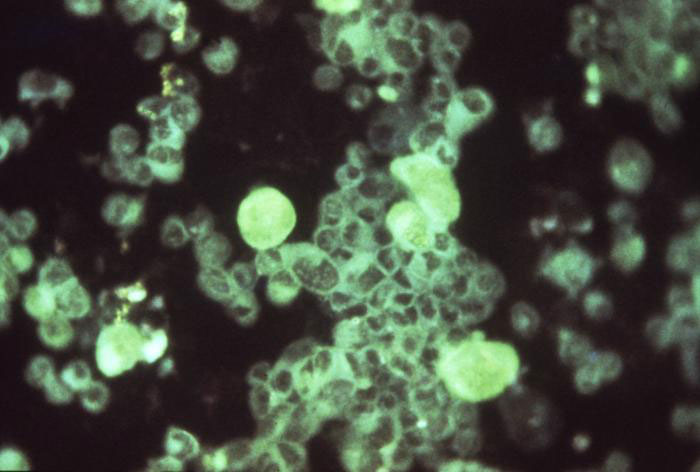
Immunoflourescent detection of Cytomegalovirus (Image: CDC USA) |
Viral infection causes systemic infection and extensive brain damage and cell death by necrosis. Cytomegalovirus infection can also occur in the human placenta.[3] |
Links: Medical Microbiology- Cytomegalovirus | Search Medical Microbiology "Cytomegalovirus"
Herpes Simplex Virus
NCBI Bookshelf (external link) Search Medical Microbiology "Herpes Simplex Virus"
Search PubMed: term = Herpes Simplex Virus teratology | embryo infection | fetal infection | neonatal infection
Human Papilloma Virus
- Links: CDC STD Facts - Human papillomavirus | Medline Plus Human Papillomavirus | Human Menstrual Cycle - PapSmear)
Polio Virus
Poliomyelitis (polio) is a highly infectious viral disease, affecting only humans of any age, but mainly children under the age of 3 (> 50% cases) causing paralysis and death. There are three types (type 1, type 2, and type 3) of wild poliovirus which can invade the nervous system and can cause total paralysis in several hours. Polio cases have decreased by more than 99% since 1988.
- 1988 - estimated 350,000 cases in more than 125 endemic countries
- 2006 - 1997 reported cases
- 2008 - only parts of four countries in the world remain endemic for the disease
A bivalent oral polio vaccine (BOPV) is presently being used in countries with high existing polio rates, India and Nigeria. A recent WHO release has shown the largest ever year-to-year drop in polio cases following the use of BOPV:
- Nigeria - has seen a 98% drop in polio cases (2009 over 400 cases to 2010 just 9 so far)
- India - has seen a 90% drop during the same period.
Human Immunodeficiency Virus
Pubmed Coll O, Suy A, Hernandez S, Pisa S, Lonca M, Thorne C, Borrell A. Prenatal diagnosis in human immunodeficiency virus-infected women: a new screening program for chromosomal anomalies. Am J Obstet Gynecol. 2006 Jan;194(1):192-8.
Search PubMed: term = Human Immunodeficiency Virus teratology | embryo infection | fetal infection | neonatal infection
Links: British HIV Association Guidelines for management of HIV and hepatitis C coinfection in adults | Guidelines for the management of HIV infection in pregnant women and the prevention of mother-to-child transmission of HIV, 2005 | Guidelines for management of HIV and hepatitis B coinfection in adults | World Health Organization HIV-infected women and their families: psychosocial support and related issues. A literature review. 2003
Hepatitis Virus
| Hepatitis (inflammation of the liver) is caused in humans by one of 7 viruses (A, B, C, D, E) with the 2 additional F has not been confirmed as a distinct genotype; and G is a newly described flavivirus.
"All of these viruses can cause an acute disease with symptoms lasting several weeks including yellowing of the skin and eyes (jaundice); dark urine; extreme fatigue; nausea; vomiting and abdominal pain. It can take several months to a year to feel fit again." (CDC text). Virus particles measure 42nm in overall diameter and contain a 27nm diameter DNA-based core. |
Hepatitis Transmission Risk to the Fetus
Hepatitis A
- Fetal transmission of virus occurs with extreme rarity.
Hepatitis B
- Can occur as a consequence of intrapartum exposure, transplacental transmission, and breastfeeding.
- 20%–30% of HBsAg-positive/HbeAg-negative women will transmit virus to their infants.
- 90% of HBsAg- and HBeAg-positive women will transmit virus to their infants.
- Immunoprophylaxis at birth with both HBIG and Hepatitis B vaccine within 12 hours of birth decreases the risk of transmission.
- Passive (HBIG) and active immunization is 85%–95% effective in preventing neonatal HBV infection.
Hepatitis C
- The overall risk of transmission is approximately 5%–10% with unknown maternal viral titers.
- All pregnant women with HCV should have viral titers performed.
Search PubMed: term = Hepatitis Virus teratology | embryo infection | fetal infection | neonatal infection
Influenza Virus
Flu is the general term and abbreviation of influenzaviral infections and the possible teratogenic effect of influenza viruses (orthomyxoviruses, "flu") is unclear, with very little evidence directly linking the two events. A relatively recent study was unable to identify any placental transmission of influenza virus during the second and third trimester. Severe maternal infection though may lead to hyperthermia, which has been demonstrated to be teratogenic, particularly in early neural development. (More? [hyperthermia.htm Maternal Hyperthermia])
Influenza virus infection in the second and third trimesters of pregnancy: a clinical and seroepidemiological study.[7] "We found no evidence for transplacental transmission of influenza virus or auto-antibody production in pregnancies complicated by influenza infections. There was an increase in the complications of pregnancy in our influenza cohort."
Postnatally, the suggested initial limited neonatal immune system makes postnatal infection dangerous.
See also: Transmission of influenza A in human beings.[8]
- Links: Medline Plus - Flu | Search Medical Microbiology "orthomyxovirus"
Swine Influenza Virus
In 2009 a global pandemic of the novel influenza A (H1N1) or Swine Flu has occurred. At this stage the possible teratogenic effect of this influenza virus should be considered the same as those described for the influenza virus above. The term "Pandemic" refers only to the spread of the virus, not the severity of the infection or potential developmental outcomes. This virus has also been spreading in an unseasonable pattern, that is in the northern hemisphere summer, when typically viral infections increase in the winter period.
H1 refers to one of the hemagglutinin subtypes (H1, H2 or H3) and N1 refers to one of the two neuraminidase subtypes (N1 or N2). Over the last century there have been at least three different human viral pandemic circulating strains H1N1 (1918, 1977), H2N2 (1957) and H3N2 (1968).
| Region | Number of Confirmed Cases(10 July 2009 based upon online data) | Number of Confirmed Deaths |
| USA | 37,246 | 211 |
| Mexico | 11,699 | 121 |
| Canada | 9,717 | 39 |
| UK | 9,718 | 14 |
| Europe | 13,667 | 16 |
(Table data source: BMJ 2009;339:b2840)
Confirmed infections per million population (July 2009)
- Australia and New Zealand - 462
- Britain - 158
- USA - 118
Australia - H1N1 Influenza 09 (Human Swin Flu) Facts
- Incubation period: maximum = 7 days (3 days would be more common)
- Period of communicability: from 24 hours prior to the onset of symptoms until:
- adults 12-64 yrs = 7 days
- adults >65 yrs = 14 days
- children <12 yrs = 14 days (or until resolution of fever, whichever is longer)
- Means of virus transmission: most likely to be spread from person-to-person by inhalation of infectious droplets produced while talking, coughing and sneezing; transmission may also occur through direct and indirect (fomite) contact.
Australian State Information
- NSW http://www.health.nsw.gov.au/publichealth/swine_flu.asp
- Public health offices in NSW Area Health Service Areas can be found at: http://www.health.nsw.gov.au/publichealth/swine_flu.asp
- Victoria http://www.health.vic.gov.au/ideas/diseases/swine-influenza
- Queensland http://access.health.qld.gov.au/hid/InfectionsandParasites/ViralInfections/swineFlu2009_fs.asp and http://www.health.qld.gov.au/swineflu/html/hc_resources.asp
- WA http://www.public.health.wa.gov.au/2/949/2/swine_flu.pm and http://www.public.health.wa.gov.au/3/952/3/human_swine_flu_health_providers.pm
- SA http://www.flu.sa.gov.au/Swineflu.aspx and http://www.health.sa.gov.au/pandemicinfluenza/
- NT http://www.health.nt.gov.au/Centre_for_Disease_Control/index.aspx and http://www.health.nt.gov.au/Emergency_Management_and_Disaster_Arrangements/Pandemic/index.aspx
- Tasmania http://www.pandemic.tas.gov.au/ and http://www.pandemic.tas.gov.au/what_does_it_mean_to_you/health_sector
- ACT http://health.act.gov.au/c/health?a=da&did=10098808&pid=1240874209 and http://www.health.act.gov.au/c/health?a=da&did=11044035&pid=1242181681
(Facts from: Australian Commonwealth Department of Health and Ageing H1N1 Influenza 09 (Human Swine influenza) – Summary Sheet for General Practitioners Current as of 24 May 2009)
UK Information
20 July 2009: Chief Medical Officer's advice to pregnant women"Some pregnant women who catch the H1N1 (swine) ‘flu virus will develop complications of the infection (including pneumonia) that could put their own and their baby’s health at risk. The risks are greatest in the second and third trimesters of pregnancy. It is too early in the pandemic of influenza to be able to quantify these risks for the individual but most pregnant women who catch the disease are likely to make an uncomplicated recovery...."
Links: WHO - H1N1 Pandemic | USA CDC - H1N1 Flu | Medline Plus - H1N1 Flu (Swine Flu) | GenBank sequences from pandemic (H1N1) 2009 viruses
Avian Influenza Virus
Lassa Virus
Adenovirus
Adenoviruses have a double-stranded linear DNA structure. This virus family is the causative agent of membrane infections in: respiratory tract, eyes, gastrointestinal tract, and urinary tract.
Modified adenovirus is currently used as a research tool to introduce genes into cells in vitro and in animal systems.
Links: Medical Microbiology - Adenoviruses | Search Medical Microbiology "adenovirus"
References:
Gordon JW. Adenovirus gene transfer vector toxicity to mouse embryos: implications for human IVF. Hum Reprod. 2002 Sep;17(9):2380-7.
Coxsackie
Echoviruses
Echoviruses are RNA viruses found in the gastrointestinal tract that belongs to the genus Enterovirus of the Picornaviridae family. These viruses do not seem to damage the fetus.
Mumps
Mumps (epidemic parotitis) is a viral inflammation of the parotid glands, which are the major salivary glands in humans. This viral infection may cause increased early and late fetal death and neonatal mumps. Note that parotid inflammation can also occur during bacterial infections.
Marburg Virus
Prevention
References
Reviews
Articles
Search Pubmed
Search Pubmed: embryo viral Infection | fetal viral Infection
External Links
Glossary Links
- Glossary: A | B | C | D | E | F | G | H | I | J | K | L | M | N | O | P | Q | R | S | T | U | V | W | X | Y | Z | Numbers | Symbols | Term Link
Cite this page: Hill, M.A. (2024, May 2) Embryology Abnormal Development - Viral Infection. Retrieved from https://embryology.med.unsw.edu.au/embryology/index.php/Abnormal_Development_-_Viral_Infection
- © Dr Mark Hill 2024, UNSW Embryology ISBN: 978 0 7334 2609 4 - UNSW CRICOS Provider Code No. 00098G


